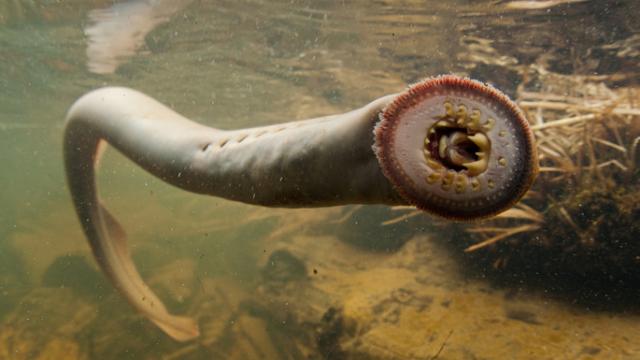The lamprey — a jawless, toothy suction funnel that looks like it sprung to life out of the Alien storyboards — is the sort of creature whose existence most of us would prefer not to dwell on. But lampreys are among the most efficient swimmers on Earth, and their unusual stroke could help engineers design low-cost underwater vehicles.
Writing in Nature Communications yesterday, a team of researchers reports that lampreys and jellyfish don’t swim in the usual manner of beating back the fluid around them. Rather, these critters pull themselves through water via suction, by generating a low pressure zone in their immediate vicinity. It’s a very atypical means of propulsion, and it’s got one of the lowest energy bills of any type of swimming.
To study the movements of lampreys and jellies, Stanford University’s John Dabiri and colleagues placed the animals in tunnels where the water was seeded with microscopic glass beads, allowing the motion of the surrounding fluid to be accurately traced. Both animals, the researchers found, use coordinated undulations to create vortices in the surrounding fluid. These vortices travel down the length of the swimmer, generating a local region of low pressure. This, in turn, creates a forward pull, effectively sucking the animal through the water.
Lamprey eel (black outline) swimming in a water tank. Colours indicate low-pressure suction forces (blue) and high-pressure pushing forces (red) generated by the animal as it swims. Colorbar indicates pressure in units of Pascals (Newtons per square meter). Playback is approximately 1/60 of real time. Image Credit: John O. Dabiri
Nearly all animals move forward by pushing back on the surrounding fluid, whether that’s air or water. For swimmers, this type of propulsive thrust is associated with high pressures zones near the body, with more thrust generating greater speeds. But if speed isn’t your primary goal, a lower energy stroke might make more sense. Write the researchers:
This fundamentally different approach to locomotion — using suction instead of pushing against the fluid — presents altogether different design constraints and opportunities for efficient swimming. As such, it encourages a reexamination of hypothesized evolutionary adaptations in swimming animals. Moreover, it suggests a different set of design objectives to be pursued for bio-inspired underwater vehicles.
Who knows, maybe in the not-too-distant future we’ll be exploring Europa’s ocean with a robotic lamprey, scaring the bejeezus out of any half-sentient life forms we encounter. Now that would be an interesting twist on first contact.
[Read the full scientific paper at Nature Communications]
Top image: A Pacific Lamprey, via USFWS/Flickr
